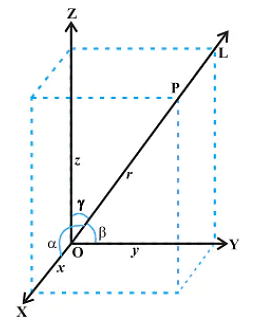Let a unit vector \( \mathbf{OP} \) make angles \( \alpha, \beta, \gamma \) with the positive directions of the coordinate axes \( OX, OY, OZ \), respectively, where \( \beta \in [0, \frac{\pi}{2}] \), and \( \mathbf{OP} \) is perpendicular to the plane through the points \( (1,2,3) \), \( (2,3,4) \), and \( (1,5,7) \). Then which one of the following is true?
- $\alpha \in\left(0, \frac{\pi}{2}\right)$ and $\gamma \in\left(0, \frac{\pi}{2}\right)$
- $\alpha \in\left(\frac{\pi}{2}, \pi\right)$ and $\gamma \in\left(\frac{\pi}{2}, \pi\right)$
- $\alpha \in\left(\frac{\pi}{2}, \pi\right)$ and $\gamma \in\left(0, \frac{\pi}{2}\right)$
- $\alpha \in\left(0, \frac{\pi}{2}\right)$ annd $\gamma \in\left(\frac{\pi}{2}, \pi\right)$
The Correct Option is B
Solution and Explanation
We are given three points \((1, 2, 3)\), \((2, 3, 4)\), and \((1, 5, 7)\), and we need to find the angle that the unit vector \(\overrightarrow{OP}\) makes with the coordinate axes.
Step 1: Equation of the Plane
The equation of the plane can be determined using the determinant of a matrix formed from the coordinates of the points:
\[ \begin{vmatrix} x - 1 & y - 2 & z - 3 \\ 1 & 1 & 0 \\ 3 & 1 & 4 \end{vmatrix} = 0. \]
Expanding this determinant gives:
\[ (x - 1) \cdot 4 - (y - 2) \cdot 3 + (z - 3) \cdot 2 = 0. \]
Simplify:
\[ x - 4y + 3z = 2. \]
Thus, the equation of the plane is:
\[ x - 4y + 3z = 2. \]
Step 2: Direction Ratios of the Normal to the Plane
The direction ratios of the normal to the plane are \(\langle 1, -4, 3 \rangle\).
Step 3: Direction Cosines of the Normal Vector
The direction cosines of the normal vector are given by:
\[ \cos\alpha = \frac{-1}{\sqrt{26}}, \quad \cos\beta = \frac{4}{\sqrt{26}}, \quad \cos\gamma = \frac{-3}{\sqrt{26}}. \]
Step 4: Finding the Angles
The angles \(\alpha\), \(\beta\), and \(\gamma\) correspond to the direction cosines:
- \(\cos\beta = \frac{4}{\sqrt{26}}\), so \(\beta \in [0, \frac{\pi}{2}]\).
- \(\cos\alpha = \frac{-1}{\sqrt{26}}\), so \(\alpha \in [\frac{\pi}{2}, \pi]\).
- \(\cos\gamma = \frac{-3}{\sqrt{26}}\), so \(\gamma \in [\frac{\pi}{2}, \pi]\).
Conclusion
The correct answer is:
\[ \boxed{1}. \]
Top Questions on Three Dimensional Geometry
- If $(\alpha, \beta, \gamma)$ is the foot of the perpendicular drawn from a point $(-1,2,-1)$ to the line joining the points $(2,-1,1)$ and $(1,1,-2)$, then $\alpha+\beta+\gamma=$
- TS EAMCET - 2025
- Mathematics
- Three Dimensional Geometry
- If A(2,1,-1), B(6,-3,2), C(-3,12,4) are the vertices of a triangle ABC and the equation of the plane containing the triangle ABC is $53x+by+cz+d=0$, then $\frac{d}{b+c}=$
- TS EAMCET - 2025
- Mathematics
- Three Dimensional Geometry
- If m:n is the ratio in which the point $\left(\frac{8}{5}, \frac{1}{5}, \frac{8}{5}\right)$ divides the line segment joining the points (2,p,2) and (p,-2,p) where p is an integer then $\frac{3m+n}{3n}=$
- TS EAMCET - 2025
- Mathematics
- Three Dimensional Geometry
- Let $\pi_1$ be the plane determined by the vectors $\hat{i}+\hat{j}, \hat{i}+\hat{k}$ and $\pi_2$ be the plane determined by the vectors $\hat{j}-\hat{k}, \hat{k}-\hat{i}$. Let $\vec{a}$ be a non-zero vector parallel to the line of intersection of the planes $\pi_1$ and $\pi_2$. If $\vec{b} = \hat{i}+\hat{j}-\hat{k}$ then the angle between the vectors $\vec{a}$ and $\vec{b}$ is
- TS EAMCET - 2025
- Mathematics
- Three Dimensional Geometry
Show that the following lines intersect. Also, find their point of intersection:
Line 1: \[ \frac{x - 1}{2} = \frac{y - 2}{3} = \frac{z - 3}{4} \]
Line 2: \[ \frac{x - 4}{5} = \frac{y - 1}{2} = z \]
- CBSE CLASS XII - 2025
- CBSE Compartment XII - 2025
- Mathematics
- Three Dimensional Geometry
Concepts Used:
Three Dimensional Geometry
Mathematically, Geometry is one of the most important topics. The concepts of Geometry are derived w.r.t. the planes. So, Geometry is divided into three major categories based on its dimensions which are one-dimensional geometry, two-dimensional geometry, and three-dimensional geometry.
Direction Cosines and Direction Ratios of Line:
Consider a line L that is passing through the three-dimensional plane. Now, x,y and z are the axes of the plane and α,β, and γ are the three angles the line makes with these axes. These are commonly known as the direction angles of the plane. So, appropriately, we can say that cosα, cosβ, and cosγ are the direction cosines of the given line L.
